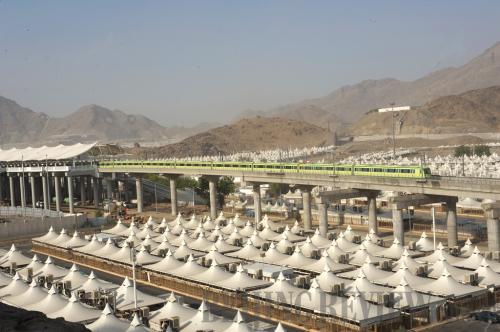|
 |
|
HOLY BUT COSTLY: A light rail train runs on a trial basis last November in Mecca, Saudi Arabia. The project caused China Railway Construction in charge of the project to lose $63.89 million (JIANG SHUFAN) |
The regulator of China's state-owned assets on June 27 announced new measures to supervise overseas assets of centrally administered state-owned enterprises (SOEs) amid what the State-Owned Assets Supervision and Administration Commission (SASAC) called "increasing complexities."
The newly announced pair of regulations aim to stop management loopholes and improve the safety of SOEs' overseas assets.
The Interim Regulations on the Supervision and Administration of Overseas Assets of Central SOEs concern central SOEs' overseas investment, management and various operating activities, both internal and external. The Interim Regulations on the Administration of Overseas Property Rights of SOEs regulate registration, assessment, examination and transmission of the overseas properties of central SOEs and set out requirements for the equity management of red-chip companies, mainland-based companies that are incorporated internationally and listed on the Hong Kong Stock Exchange.
The release of the two interim provisions is an important measure for SASAC to fulfill its responsibility as state-owned assets owner, complete the accountability mechanism for preserving and increasing the value of state-owned assets and enhance the management of SOEs' overseas assets, SASAC said. It is conducive to helping China's SOEs foster world-class competitive enterprises and accelerating the internationalization of their management strategies.
SASAC's new regulatory measures standardize individual equity holdings on behalf of SOEs, which used to lead to losses of assets overseas. Any transaction of equity holding that would change the holding status of SOEs must get the approval from SASAC, said the interim regulation. Those responsible for the loss of overseas assets and mismanagement will be held accountable by the SASAC in accordance with relevant laws and regulations on state-owned assets management.
Costly lessons
Since China entered the WTO in 2001, its SOEs have been the major pioneering force in overseas investment. The global financial crisis in 2008 has been the catalyst for the move. Official figures show 100 out of 120 central SOEs have established overseas branches or administrative organizations. The overseas assets of SOEs amounted to 4 trillion yuan ($610 billion) at the end of 2010, accounting for 20 percent of their total assets.
Ironically, while Chinese SOEs were obsessed with outbound investment mania, their regulators seemed to be stood idle. The fact is the latest regulations on overseas state-owned assets could be dated back to 1999. China established the SASAC particularly for the supervision and management of SOEs, but it still failed to fulfill the responsibility of monitoring the overseas operation of SOEs as evidenced by a series of losses in overseas investment in recent years.
China Aviation Oil (Singapore) lost about $550 million from ill-placed bets on oil prices in 2004. The Chief Executive Chen Jiulin was sentenced to 1,035 days in prison. This year China Railway Construction reported a loss of 4.153 billion yuan ($63.89 million) from its light railway project in Saudi Arabia.
The war in Libya has affected 50 projects undertaken by 75 Chinese enterprises involving $18.8 billion, said the Ministry of Commerce.
A report released by the National Audit Office this May said Sinochem Group, China's biggest chemical trader, lost $15.27 million in its three overseas oil gas projects and another two did not produce profits as high as expected.
While Chinese SOEs witness a dramatically growing outbound investment, the risks are also increasing, said Wang Yong, SASAC Minister.
Wang also summarized the reasons for the investment failure of SOEs. Some did not choose the right projects to invest in as the projects have too little correlation with their main business; some advanced their outbound expansion too fast, exceeding their own capital, management and talent capability; some lacked strict and complete regulations and rules on overseas investment; some were weak in risk management and in the ability to control risks; and some even entangled with mutual competitions.
The management of overseas assets was slack with insufficient risk-control measures among SOEs, compared to their emphasis on overseas investments, Wang said.
With the acceleration of their going global, SOEs must enhance their risk control, he said.
| 